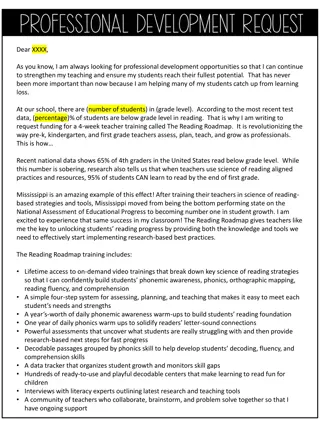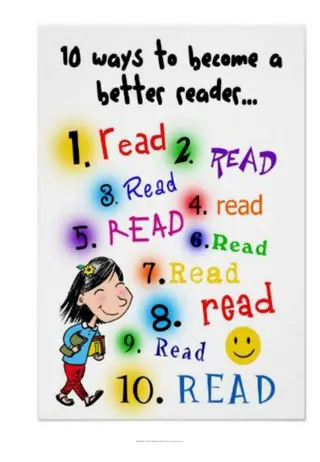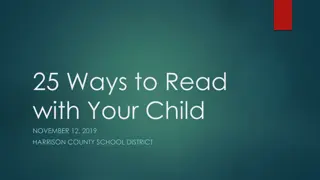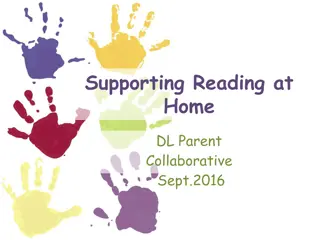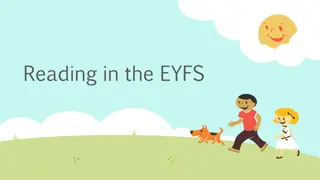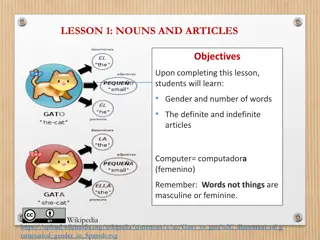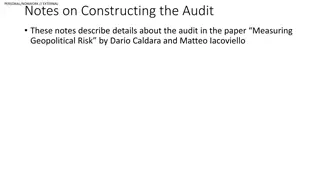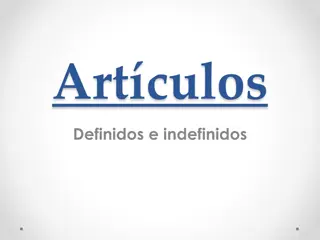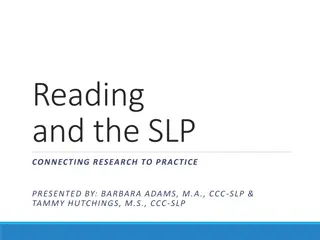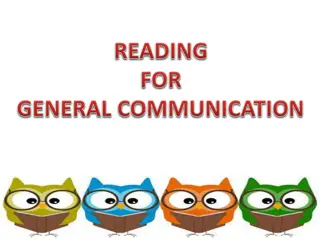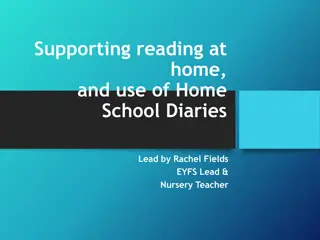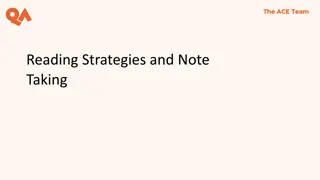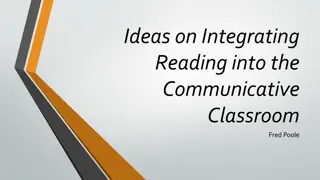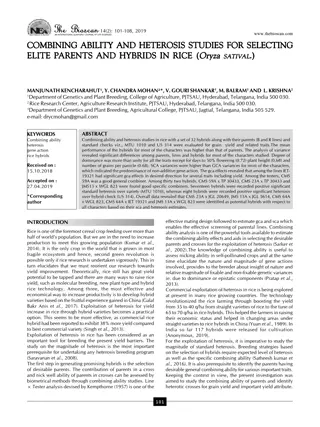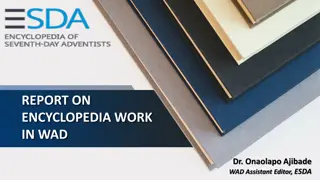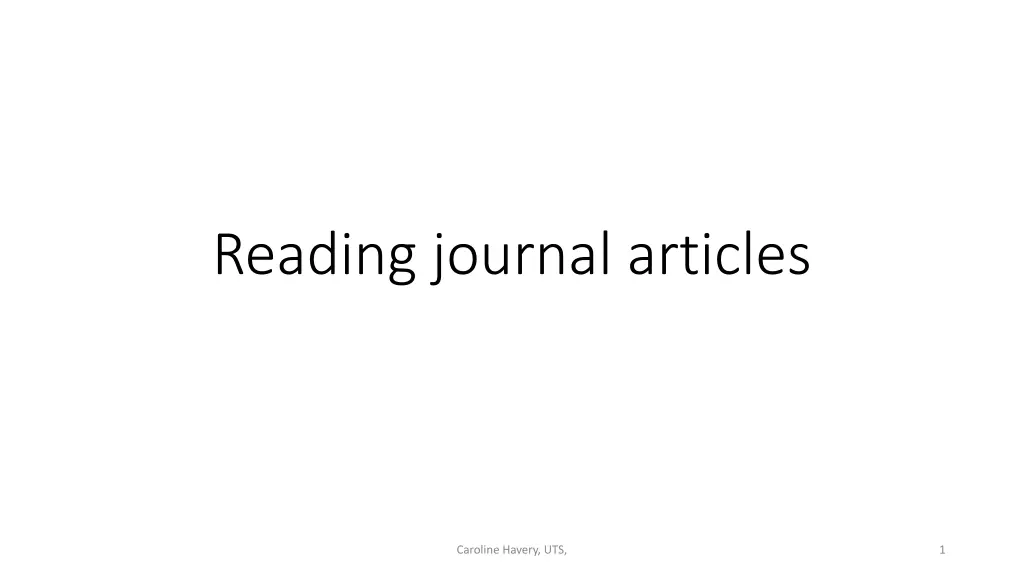
Understanding Journal Articles: A Guide for Critical Reading
Learn about the importance of being a critical reader when engaging with peer-reviewed journal articles written by academics/researchers. Discover key tips on how to assess the credibility and relevance of sources for evidence-based decision-making, especially in healthcare settings like nursing.
Download Presentation

Please find below an Image/Link to download the presentation.
The content on the website is provided AS IS for your information and personal use only. It may not be sold, licensed, or shared on other websites without obtaining consent from the author. If you encounter any issues during the download, it is possible that the publisher has removed the file from their server.
You are allowed to download the files provided on this website for personal or commercial use, subject to the condition that they are used lawfully. All files are the property of their respective owners.
The content on the website is provided AS IS for your information and personal use only. It may not be sold, licensed, or shared on other websites without obtaining consent from the author.
E N D
Presentation Transcript
Reading journal articles Caroline Havery, UTS, 1
2 What are journal articles? What are journal articles? Journals are written by academics/researchers They are usually written for other academics (i.e. they ae not directly written for students so they are usually harder to read than a textbook) A peer reviewed journal article means that the articles were read by other experts before they were accepted for publication There are different types of journal articles
Reading for evidence: being a critical reader Reading for evidence: being a critical reader Peer reviewed journal articles are a good place to begin if you are looking for good evidence because they have already been read and approved of by experts in the field BUT you still need to be a critical reader Ask these questions begin to think critically about something you are reading (or listening to) Where was it published? When was it published? Who wrote it? Why did they write it? (to inform people, to report on research, to persuade you about something etc.) What evidence are they using/where did they get the information? 3
Key learning points Key learning points It is important that you are a critical reader so that you can make decisions as a nurse based on good evidence Caroline Havery, UTS, 4
Purpose in reading Purpose in reading Before you start reading you need a PURPOSE for reading. The purpose is often related to an assignment. Today our purpose for reading is to begin to prepare for Assignment 1. We want to find out information about diarrhoeal disease and especially the information we need to complete the assignment Caroline Havery, UTS, 5
Find the answers to these questions Find the answers to these questions Where was it published? When was it published? Who wrote it? Why did they write it? (to inform people, to report on research, to persuade you about something etc.) What evidence are they using/where did they get the information? Caroline Havery, UTS, 6
Date it was published Name of journal Title of the article tells you what it is about and how they got their information Authors Caroline Havery, UTS, 7
Usually there is information about where the authors work Caroline Havery, UTS, 8
Preliminary reading (skimming) Preliminary reading (skimming) Before you read in detail, you want to skim the text to get an overview. Why? To decide whether this is something it is worth spending time reading To get an idea what it is about it will then be easier to read Because you have limited time and just want to get a quick overview Caroline Havery, UTS, 9
This are good strategies to use when you are searching for articles They are also good strategies to use to get a quick idea of what the article is about and to help you decide if you want to read it in more detail The strategies can also help you decide which parts of the article might be most useful to read 10
After class work: Do your own preliminary reading After class work: Do your own preliminary reading Spend 15 minutes and see how much you can understand the reading. Remember to use any subtitles to help you quickly get an idea of what the reading is about Read the introduction and conclusion Caroline Havery, UTS, 11
Follow up on after class work: What did you find out about the Follow up on after class work: What did you find out about the article article Tell your group what you already know about the article What did you do to get that information how did you read and what did you read? Caroline Havery, UTS, 12
13 Use the structure of a journal article to help you read Use the structure of a journal article to help you read Abstract Summarises the whole paper Introduction Background, what research has been done before, purpose of this paper. Methods How the research/or literature review was done. Results What the authors found Discussion What the results mean. How do the results from this study compare with what other studies have found. Conclusion Summary of key points. Sometimes limitations. Often implications what does the study mean for practice or future research?
Which sections should you read? Which sections should you read? In journal articles, reading the introduction and conclusion will give you an overview of the key points Other sections of the text will give you different information you do not always have to read the whole journal article. What you need to read depends on WHY you are reading Caroline Havery, UTS, 14
Read the introduction to get an idea of what the paper is about Read the introduction to get an idea of what the paper is about If you read the beginning and the last paragraph of the introduction, you will probably find out what the background is and what the purpose of the paper is The other paragraphs will give you information about things that are already known about this topic/problem Reading the topic sentences will give you an outline of the arguments the writers are making 15
16 Footer What is a topic sentence? What is a topic sentence? The topic sentence is usually (but not always) the first sentence in the paragraph. It summarises what the paragraph is about.
Stop and think Stop and think Write down a few things you have heard so far that you think you can try when you read your next journal article 17
Lets read the introduction of this article Let s read the introduction of this article Background As evident in the Sustainable Development Goal (SDG) six, proper sanitation has been one of the topmost priorities on the global public health agenda [1, 2]. This is because inadequate sanitation leads to the spread of disease-causing organisms through faeces and urine [3]. These organisms cause a variety of diseases, including cholera, diarrhoea, dysentery, hepatitis A, typhoid, and polio [4]. Globally, there are over 2.3 billion people without access to improved sanitation [5]. Research by Global Burden of Disease [6] pegged the global sanitation related deaths at 775,000 annually. In low- and middle-income countries, about 5% of all deaths result from poor sanitation, while the global average is 1.4%. In the Pacific, about 70% of the population still use unimproved sanitation facilities, with 13% practicing open defecation [7]. The situation is worse in Papua New Guinea, where only 19% of the population have access to improved sanitation [7]. Caroline Havery, UTS, 18
Can you answer? Can you answer? What is the health problem that his article is about? What is one of the main causes of this health problem? What is the situation in PNG regarding this health problem? Caroline Havery, UTS, 19
Paragraph 2 from the introduction Paragraph 2 from the introduction In the past few decades, sanitation programs targeting household sanitation have often paid little attention to the disposal of children s stools. This results from the belief that children s stools or faeces are less harmful compared to faeces of adults [8, 9]. However, that belief has been proven to be false, as evidence suggests that children s stools can cause more serious faecal contamination in the household environment [10]. This is because, through some behaviour such as playing on the ground or crawling, children get their fingers exposed to faecal pathogens. Such children are also likely to put pica or fomite into their mouths [10]. It is, therefore, very important for every household to practice safe disposal of children s faeces by putting the faeces into toilet/latrine or burying it. Practices such as putting it in a drain or ditch, and throwing it in the garbage or in the open are considered unsafe practices [11]. Caroline Havery, UTS, 20
Can you answer? Can you answer? Why is it important to throw away children s faeces safely? What are some safe ways of throwing away children s faeces? What are some unsafe ways of throwing away children s faeces? Caroline Havery, UTS, 21
Introduction 3 Introduction 3rd rd paragraph paragraph Previous studies in India [12, 13], Bangladesh [14], Nigeria [15], Burkina Faso [16], and Ethiopia [17] have revealed positive associations between disposal of children s stool, and individual/maternal and contextual/ household factors. These studies have shown that women with high wealth status, those with higher levels of education [15, 16], women who live in urban areas [17], and those who have access to improved toilet facility [12, 17, 18] are more likely to safely dispose of children s stool. These studies have provided adequate literature through their findings and recommendations which include strengthening policies that can increase caregivers awareness and practice of safe sanitation practices at all levels and in all livelihood domains [15, 16]. However, to the best of our knowledge, no study of this kind has been conducted in Papua New Guinea. In the present study, we sought to assess the individual and contextual factors associated with disposal of children s stools in Papua New Guinea. This work will be beneficial to sanitation programs aimed at promoting safe disposal of children s faeces. Caroline Havery, UTS, 22
Can you answer? Can you answer? What are some of the factors that influence whether caregivers throw away faeces safely according to previous research? What is this paper about? Caroline Havery, UTS, 23
So an introduction So an introduction Gives you background to the topic Tells you what research has been before Tells you what research is missing still (often this is called the gap) Tells you what this article is about (usually filling the gap Caroline Havery, UTS, 24
Then read the conclusion Then read the conclusion Policy implications The results from the study have revealed that there is relatively low prevalence of safe disposal of children s faeces in Papua New Guinea. There are both individual and contextual factors associated with disposal of children s stools. It is recommended that various policies and programs aimed at improving safe disposal of children s faeces should focus on both individual and contextual factors. Specifically, sanitation programs should focus on behavioral change and not only on the extension of water and improved toilet facilities. Conclusion The individual level factors associated with disposal of children s faeces are child s age, maternal age, and women visiting health facility for child diarrhea while the contextual factors are region of residence, sex of household head, type of toilet facility, and source of drinking water. Further studies could assess the association between the availability of hand hygiene resources (presence of water and soap for handwashing) and disposal of children s stools. Caroline Havery, UTS, 25
Can you answer? Can you answer? What is the situation in PNG with disposing safely of children s faeces? What should future policies focus on? What are some of the individual factors that influence whether parents throw away faeces safely? What are some of the contextual factors that influence whether parents throw away faeces safely? Caroline Havery, UTS, 26
After class work: Write some notes After class work: Write some notes Spend 15 minutes writing what you now know from the article: What are the main points that you have understood? What information do you have so far to help you answer the questions for Assessment 1? What do you still need to find out? Caroline Havery, UTS, 27

